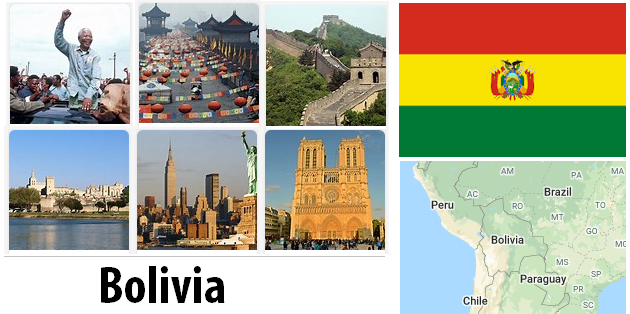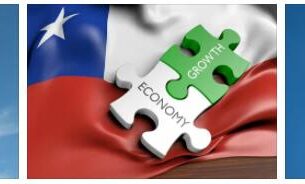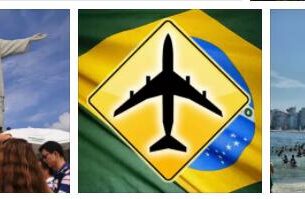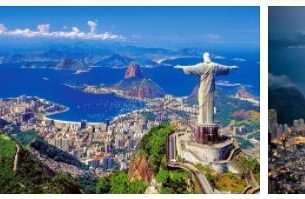Until a century and a half ago Bolivia belonged to Spain with the name of High Peru.
In 1535 the Spanish adventurer Diego de Almagro was the first European to set foot on the territory currently called Bolivia. He found it already inhabited by Indian tribes among which the more advanced ones of the Qhueciua were in the north-western part of the country and the Aymarà had settled around Lake Titicaca. South of this lake were the Uru, who arrived in the country in ancient times. In the north-eastern part of the territory there was the Guarayu tribe. Other very ancient tribes, those of Tapiete, Mataco, Choroti, occupied the low plateau of Chaco. Even today descendants of these tribes are found.
In 1530 the Emperor of Spain Charles V had commissioned three brothers, the Pizarro, to occupy the territories of South America on his behalf.
They decided to begin the conquest of Peru which then also included the northern provinces of Chile and Argentina, all of present-day Bolivia and Ecuador. The enterprise was soon fraught with difficulties because the Indians from the beginning resisted strenuously.
Two of the Pizarro brothers, Francesco and Fernando, were engaged for a long time in Lower Peru to face a rebellion of indigenous people. Gonzalo, the third, in the meantime reached the Cochabamba valley in the center of the territory.
Fernando Pizarro, starting from Lower Peru, in 1538 occupied the land on which Diego de Almagro had landed; he decapitated him, exterminated the Incas, ancient Peruvian kings, and founded the city of Lima. (In turn Fernando Pizarro was later killed by the son of Diego de Almagro, who thus wanted to avenge his father).
He realized the enormous wealth of that land and in his conquest initiative was helped by his brother Gonzalo who had to face bitter battles before being able to fix his center in Charcas. There he rebuilt the indigenous city of Chuquisaca which then assumed the name of La Plata (today Sucre). The whole area remained united with the Viceroyalty of Peru until 1776.
In 1563 the Real Audiencia de Charcas was created, with the capital Chuquisaca, which extended its jurisdictional powers to Tucuman, Paraguay, and Pugno, a Peruvian province.
For a long time Spain exploited the rich silver mines of Oruro and Potosì, demanding one fifth of the production, and those of mercury of Huancavelica, so large as to employ fifty thousand workers.
Although the wars of conquest were the bearers of horrors and death, they also gave way to a human colonization of the natives with the establishment of humanitarian bodies such as the Obra Pia di Paria. From 1571 to 1825 this institution protected and educated the populations and, under the Viceroy Don Francisco de Toledo, nicknamed the “Peruvian Solon” (1569-1582), there was the complete repopulation of the Cuzco area which, due to the migratory movement towards the mines, it was left empty, a ghost town. The Aymarà gathered, who from Peruvian Indian rebels became the most loyal collaborators of those Spaniards who had previously taken them away from the tyranny of the Incas. In this period the first cities began to arise including Potosì (1545), La Paz (1548), Cochabamba (1570), Tarija (1574) and finally Oruro (1604).
And while the natives proposed themselves in a peaceful way to exploit the wealth of the possessions, the Spaniards were instead continually waging struggles also by virtue of the rivalries that arose between Pizarro and Diego de Almagro and these wars continued for a century and a half, interrupted only by the decade 1626/1636, followed later by the uprising of the “Cholos” of La Paz in 1661, which degenerated into brigandage.
Yet despite these bloody events, the country had achieved some positive accommodation. On the religious side, important bishops had been established such as in La Plata (1535), Santa Cruz de la Sierra (1605) and La Paz (1609) which all depended on the Archbishopric of Charcas, raised to this title by Pope Paul V, but submissive to the dictates of the Holy Office of the Inquisition, which could be considered a more political than religious institution.
On the economic side, great progress was made which led to the construction of the “House of Money” in 1572, under the government of the Viceroy Francisco de Toledo; in 1627 the “Consulate of Merchants” and the “Universidad de la Caridad” were established in Lima, with administrative and jurisdictional tasks.
In 1621 the Literary and Scientific University of San Francesco Saverio of Chuquisaca had already been founded, on the same statuary model as the already famous University of Salamanca.
At the same time as the wealth of the territory flourished, various sources of misery and death proliferated in the form of pests, floods and earthquakes; but the most devastating desolations were always the consequences of the recurring internal struggles.
In 1730, when the Viceroy Marquis of Castelfuerte ordered a review of the tributes, the mestizos of La Paz made a new uprising, which was successful because they obtained that the natives occupied the public offices with the total expulsion of the Spaniards.
In 1776 the Viceroyalty of Rio de la Plata was created whose territories were divided into “Corregimientos”. Also in that year the Indians of Cochabamba and Charcas rose under the command of the brothers Tommaso, Damaso and Nicola Catari (of the “Corregimientos of Potosì), followed by the mestizos of Oruro, who plundered the whole territory and beheaded entire populations of Whites.
All of this endangered the survival of the entire city of Chuquisaca; meanwhile in Cuzco, Tupac Amaru, a descendant of the Incas, taking advantage of the tragic moment, was attempting to restore the dominion already of his Peruvian ancestors. So that there were wars of races throughout the territory, so ferocious that in the three years of duration there were one hundred thousand deaths in the two factions. Tupac Amaru was executed. But this event served to demonstrate that the memory of the Incas Empire was far from dead. However, the period of rebellions had begun throughout Latin America.
In 1808, after Charles IV, king of Spain, had abdicated in favor of his son Ferdinand VII. then forced by Napoleon I to abandon the throne in the same year, there were the first signs of the collapse of the Spanish empire. In Chuquisaca, however, despite the fact that very important literary meetings were held in the important Carolina University to discuss Montesquieu’s liberal ideas, most of the intellectual environment was certainly conservative. So it wasn’t in Chuquisaca that political discord arose. In November 1808, Fr Josè Manuel Goyeneche arrived at the Charcas Academy, carrying instructions given by the Seville Council. Among other things, it had the task of making known, and defending, the claims of ownership of the Spanish colonies by Carlotta Gioacchina di Borbone, queen of Portugal. This first sparked a discord between the Governor and Audencia, a discord that soon became public. University students, under the apparent intention of defending the rights of the Spaniards, instead had deep-rooted nationalistic aims and founded a party called the “Patriotic Party”. The Governor, Don Ramon Garcia Pizarro (descendant of the conqueror Francesco) attempted to quell the riots but was taken prisoner in his own house.
It is said that on this occasion he pronounced a phrase that went down in history, namely: “With the first Pizarro the Spanish domination began here and with the last it will end”. It was May 25, 1809.
A month later the “Junta for the Protection of the Rights of the King and the People” was formed with the intention of joining the monarchy; only later did the need to free himself from Spanish domination be felt. Thus began the struggles for independence in Upper Peru which lasted fifteen years and which alternated.
Animated by this spirit of freedom, all the citizens rose up, including the Indians, commanded by Pomakaua, who in May 1815 in Secuani defeated Colonel Benavente and then joined the regular army. But the Spaniards managed to tame the insurrection and regain the upper hand.
The populations of Upper Peru did not lose heart; the riots became more frequent and bloody. See Countryaah for population and country facts about Bolivia. It was in this period that Simon Bolivar, a Venezuelan who came on the scene after being educated in Spain and having made a long journey through Europe, arrived in Rome. Here, on the ruins of the Aventine, he swore to free his homeland and other lands of South America from Spanish domination. Back in America, he embarked on wars in the North (in fact all wars were centered on Peru) and on August 6, 1824 he immediately reported an important victory in the battle of Junin and his lieutenant Sucre on December 9, 1824 he won on the Andes, in Ayacucho.
Bolivar, in fifteen sensational battles, managed to drive the Spaniards out of Venezuela, Colombia, Ecuador and the region which, in his honor, was called Bolivia. Passing from victory to victory, he triumphantly entered La Paz on March 9, 1825.
These events put an end to Spanish domination since many sympathies for the revolution had also developed in the provinces governed by the “Audiencia de Charcas”, initially realistic, the city of Cochabamba had given rise to hostilities. The Spaniards abandoned all their positions and moved to the south.
On July 10, 1825, the “General Assembly of Independent High Peru” was inaugurated in Chuquisaca, in the ancient seat of the Audiencia de Charcas. On August 6, 1825, the independence of the Argentine and Peruvian Republics was also proclaimed and on the 13th of the same month it was established that the form of government would be a unitary republic with a representative system, with the separation of the three powers: Legislative, Executive and Judicial. . Simon Bolivar was appointed as president, but he refused the post and appointed his lieutenant Sucre, who had been his most talented collaborator in the war against the Spaniards, in his place.
From the first Constitution which was discussed in the Assembly in 1826, three chambers were established: the first, that of the Censors, which was to appoint the other government representatives, control the administration and ensure compliance with the Constitution and the Treaties; the second, that of the Senators, who drew up the codes and controlled the courts; the third, that of the Tribunes, which issued laws, managed situations of peace and war and controlled executive power.
Since the proclamation of the Republic of Bolivia, many of the presidents who have followed have been discharged due to constant rebellions and eight have been murdered.
The first president, Sucre, nominated at too young an age, as a politician proved to be rather poor. Not being able not to live up to the successful performance of his mandate, he resigned and proposed two generals to the candidacy; Andres Santa Cruz and Josè Miguel de Velazco.
This designation remained without continuation because in the meantime Magarra, President of Peru, invaded Bolivia with his army, which had to succumb and accept, with the Piquiza Treaty of 6 July 1828, among other things, also the imposition of its candidate to the Presidency in the person of Pedro Blanco. After five days, however, he was deposed and put in prison where he died on January 1, 1829.
In an effort to end the rebellions, Andres Santa Cruz was appointed president, who hastened to reform the constitution by decreeing the suppression of the Chamber of Tribunes and changing the name to the other two who were called “Deputies” and “Senators” ( 1821). Santa Cruz also took care of modifying codes and laws, took great care of the administration, put public finances in order, promoted industrial activities and agriculture, the latter making significant concessions to immigrants and entered into a commercial treaty with Peru. He ruled for a decade (1829-1839) during which Bolivia achieved power, prestige and prosperity.
All this, however, increased his ambition to conquer Peru; he placed himself at the head of a mighty invading army; he defeated the Peruvians in Cuzco (1835) and ousted President Magarra. Its purpose was to rebuild the ancient Viceroyalty of Lima and with this aim it unified the main laws of the two countries, which however had to respect for each their own administration and autonomy of internal politics.
In short, he created a Peruvian-Bolivian Confederation which he headed with the nickname “Protector” (1836).
All this provoked the uprisings of both Magarra in Peru and Velazco in Bolivia and when the first defeated him in Jungay (1839) he returned to Bolivia but too late because, in the meantime, albeit temporarily, Velazco had replaced him in the presidency of the country.
Josè Ballivian, known as “El Grande”, was later president, who in 1841 had defeated Magarra in Ingavi, who had again invaded the province of La Paz.
Ballivian continued the war against Peru and upon the death of Magarra, defeated in Viacha in 1842, peace was signed with the restoration of the pre-war state. Then he promulgated the Fourth Republican Constitution which was called “Military Ordinance” (1843).
Ballivian prevailing, Bolivia experienced another period of prosperity: the exploitation of the Pilcomayo river bed in the Chaco Boreal began and the tributaries of the Amazon River were explored in order to establish a river network of communications.
But the peace did not last long and in 1848 Ballivian was ousted by the former provisional president Josè Miguel de Velazco, who in turn was ousted by Manuel Isidoro Belzù, who remained in power six years. During this time there were at least fifty rebellions which were followed by persecutions and reprisals under successive governments: the first of the son-in-law of Belzù, Jorge Cordova (1855/57) and then of the dictator José Maria de Linares and then again José Maria de Acha, continued fatal struggles that lasted from 1861 to 1864. Under the government of the latter, despite everything, public services were reorganized, new life was given to the mining industry and agriculture, reduced to a meager state under the previous presidents; important international treaties were signed for trade.
In 1866 Chile threatened to declare war on Bolivia to conquer the province of Antofagasta. In this area, along the Pacific coast, there are very rich deposits of silver, copper and saltpeter. To avoid the war, the Bolivian president allowed the Chileans to exploit the mines and large deposits of guano.
In 1868, president Mariano Melgarejo, dictator without limits, Bolivia enjoyed a series of unfavorable events but things improved in 1871/72 under the presidency of Agustin Morales who built the railway network, reorganized the districts of Mamorè and the Gran Chaco, taking advantage of its enormous natural wealth.
In 1873, after the brief government of Tomas Frias, Adolfo Ballivian, son of José, was elected who in the same year, by signing a defensive alliance with Peru, started the conflict with Chile. This conflict, however, did not immediately find the way of arms since Tomas Frias, who had returned to power in 1874, had ratified the privileges granted to Chile in 1866.
In 1876, however, President Hilarion Daza, strengthened by his almost sovereign power and raised by the ally Peru, revoked the treaty of 1866 and decided to take back the very rich deposits. Chile’s reaction was not long in coming and in 1879 the two-year war began and was fought hard by the Bolivians who, in the end, were forced to ask for an armistice and to surrender the disputed territory. Bolivia thus lost the only outlet to the Pacific Ocean, the port of Antofagasta. And this was definitively established with the ratification of the armistice in 1884.
Shortly after the war against Chile, Bolivia also found itself struggling with Paraguay, which claimed the Chaco boreal lowland, of great agricultural wealth.
When in 1810 Simon Bolivar had established the borders of the then nascent states, agreed with the Audiencia de Charcas, the Chaco Boreal had entered the limits of the Bolivian territories. Bolivia now claimed this right so as not to lose direct communication with the Atlantic after losing the one with the Pacific by giving in to Antofagasta in Chile. On the other side, Chaco Boreal’s membership in the Bishopric and Intendenza of Paraguay was invoked, which claimed that membership in Bolivia was only judicial, according to what was established by the Audiencia and that instead for both ecclesiastical and administrative matters it was natural property of Paraguay.
In 1887, after three years of struggle, the Chaco Boreal was divided into three parts: one for each of the two contenders and the third, the central one, was submitted to arbitration by the King of Belgium. And even then, despite the vicissitudes of war, Bolivia experienced other periods of prosperity, especially under the presidency of Narciso Campero, who had telegraphic networks built; privileges were granted for the exploitation of the Chaco, credits and rewards were given to agriculture, important public works were built, such as the railway between Oruro and Antofagasta, from whose port all foreign trade of Bolivia branched.




